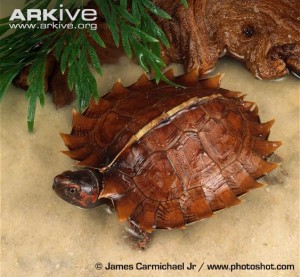The spiny turtle (scientific name:Heosemys spinosa) ranges throughout Southeast Asia. It is found in Thailand and southern Myanmar southward through Malaysia to Sumatra, Borneo and Natuna, numerous small Indonesian Islands and the Philippines.
The populations of spiny turtle are threatened by the over-collection from the wild for the Asian food market and international pet trade, as well as by the destruction of its habitat. Wild populations of spiny turtle are believed to be reducing, particularly in Indonesia, where they are considered critically endangered and known trade volumes have recently declined by about 50 %. Moreover, the extreme difficulty in breeding this species in captivity means that all specimens found in pet stores today are unfortunately still caught from the wild and freshly imported from Asia.
Captive breeding programmes or ‘turtle farms’ to supply the food and pet market are some measures to conserve the spiny turtle populations. These measures would mitigate the demand to remove large numbers from the wild. Unfortunately, this species are extremely difficult to breed in captivity and only a handful of institutions have ever successfully bred the species, including Zoo Atlanta and Knoxville Zoo in the United States and Durell Wildlife in Jersey, Europe. Information about the biology and ecology of spiny turtles which may be invaluable for conservation action in the wild are also being researched about during the breeding attempts.

